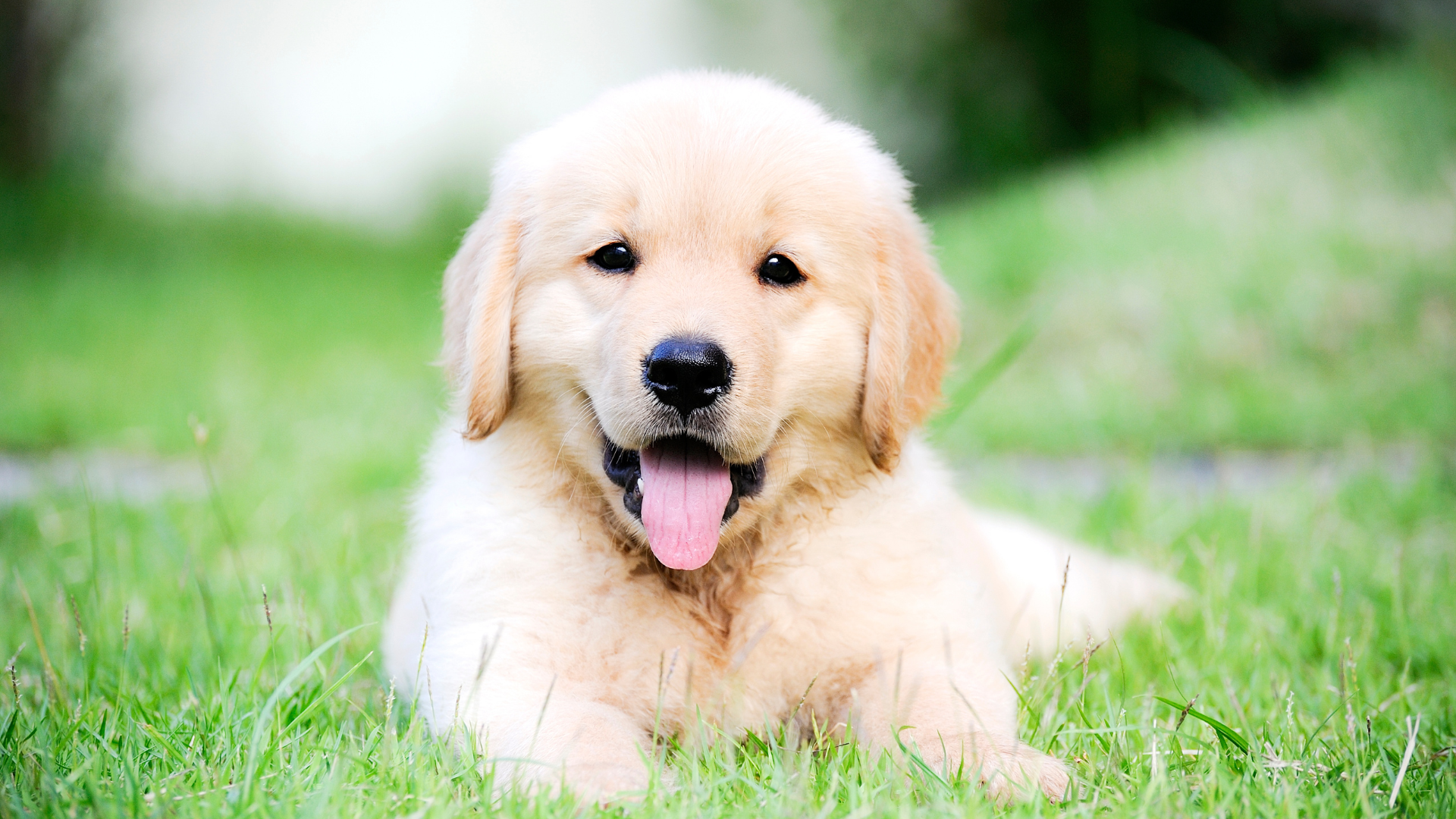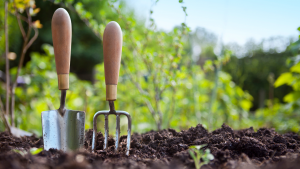Fleas have plagued humans & homes for thousands of years, and are one of the most bothersome pests to deal with. Dubbed the “vampires of the insect world”, fleas unique diet of drinking only on human & animal blood has caused a great deal of harm. The Black Death was a pandemic during the years 1346-1353 AD, which was a bubonic plague the originated from fleas, that killed over 25 million people in Europe; equivalent to 1/3 of the total population there at the time.
Bubonic plague is not the only disease carried by fleas, as they also can carry typhus, cat-scratch-disease, and parasites; like tapeworms. Fleas are not only deadly because of the diseases they carry, but also because of their rapid life cycle. A pair of mating fleas can produce a quarter of a million to 1 trillion offspring in a single year!
Conventional chemical & pesticide control is usually done using neurotoxins and other toxic substances. For example, common flea collar warning labels will warn users “not to touch the flea collar”, however, it is somehow ok for dogs or cats to wear that same collar week after week after week – being exposed to dangerous levels of neurological poisons! The standard toxic control methods can often be more harmful than the diseases carried by fleas.
If you are looking to protect your pets from fleas using natural & safe alternatives, then continue reading, as this article will provide an in-depth overview of how to get rid of fleas in & around the home and on pets.
Table of Contents:
Flea Biology & Behavior
Washing Your Furry Friend
Pestisafe® Control Inside
Pestisafe® Control Outside
Final Thoughts
Flea Biology & Behavior
The secret to controlling fleas & their infestations is properly disrupting their life cycle – so it is important to understand the complete cycle before tackling a flea infestation. Adults must contribute timely nourishment for larvae under special conditions or the young will not survive.
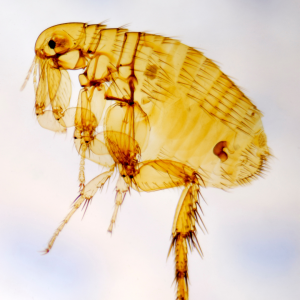
Fleas follow a standard 4 stage life cycle starting from eggs, then hatching into larvae, transitioning to pupae, and finally becoming adults.
Eggs: white, smooth, round, and very small (about the size of a pinhead at 1/33″ – 1/50″ in diameter). Typically they are dropped by the female as she feeds on her host, allowing the eggs to fall to a variety of locations, such as: the host’s bedding, dirt, carpeting, cracks in the floor, upholstery, and dust. It is possible for vacuumed eggs to hatch inside vacuum cleaners. Depending on environmental conditions, the eggs will hatch anywhere between 2 – 21 days.
Larva: slender, maggot-like, legless, covered in hairs, and often pale with brown heads. They are commonly found in bedding, soil/dirt, dust, vacuum cleaners, and floor cracks & crevices. They feed voraciously on organic debris, refuse, and dried blood. They will mature into pupae in a week to several months, and will mature faster in optimal conditions (65 – 80 F); needing a humidity of at least 50% to survive.
Pupa: larva will spin cocoons and cover itself with grains of sand & dust. Adults will emerge from cocoons usually between 5 – 7 days or some will wait as long as 1 year.
Adults: small, brown, wingless insects that are flat on both sides (laterally compressed), they are about 1/16″ 1o 1/8″ long. Fleas can jump anywhere from 8 inches high to 16 inches horizontally. Adults can go without a blood meal for several months and remain in homes long after host animals have been removed. Adult fleas will often burrow into the skin of their hosts and will continue biting even after they are full. *NOTE* in flea control, the adults make up the smallest portion of the total population, it is important to focus on disrupting the life cycle early on.
Behavior: indoors, fleas typically spend the majority of their time on/in their hosts and around their bedding. Outdoors, there are certain locations where fleas nest and it is important to note where these areas are, and to focus attention to spot-treating them.
Carpet is the perfect flea environment. Carpeting provides layers of habitat for fleas to rapidly progress throughout their life cycle, provides ample food (organic debris & dried blood), and the humidity levels can remain higher at the flea’s level than the relative humidity at ours.
Washing Your Furry Friend
There are many flea shampoos on the market but most are either ineffective or unsafe to use on pets.
If you want the best control possible, use Fleas & Ticks R Gone® for a natural & safe solution; tough on pests but incredibly gentle for pets.
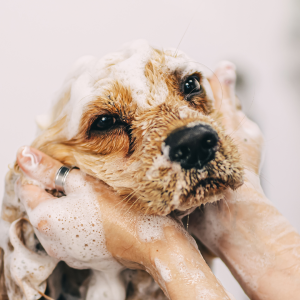
Washing Dogs
Washing dogs with Fleas & Ticks R Gone® is straightforward and the first step is drawing warm water for the bath. The warm water will not only be comforting for your dog, but will also help to activate the enzymes in Fleas & Ticks R Gone® shampoo.
How much product is needed to get rid of fleas? Typically all you will need is 1-2 oz (2 – 4 tbsp), and this can be added to the bath water. It is recommended to first wet your dogs fur and then use 0.5 – 2 oz (15 – 60 ml) of shampoo to form a lather. The shampoo amounts vary on the size of dog, thickness of fur, length of coat etc.
*Quick tip* start washing around your dogs ears and the neck area. Fleas, and other pests, will flee and try to hide in their ears to get away from the soapy water. Start in this area to block their escape.
Once you have thoroughly shampooed your dog it is important to rinse them off, and dry their wet fur.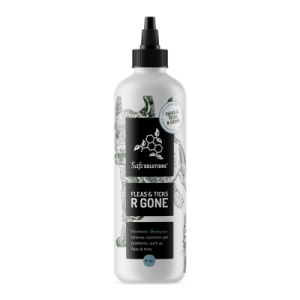
Washing Cats
Cats can be a little trickier to wash, but luckily their are some methods that can make it easier.
It is important to note, that upon welcoming a new kitten (or even a puppy) it is vital to handle, groom, and introduce water/bathing to the kitten over the first few months to a year. This will help train the cat or dog to not be afraid of grooming/bathing and make the washing process much easier, if they ever sadly become exposed to fleas or other pests.
If your cat handles baths without (or minor) complaint, they can be washed according to the above method for dogs.
For more stubborn pets, there is the “burrito method”. Take a towel and wet it with warm water. Next, take some Fleas & Ticks R Gone® and form a lather in the towel. Take your cat and fold/wrap the towel around them, forming a “cat-burrito”. Massage the cat with the towel and make sure to rub the shampoo lather all over to make sure it can remove the fleas.
Another good method for cats (or other animals) is to make a soapy solution of Fleas & Ticks R Gone®, take a fine toothed comb and dip it into the soapy solution. Then comb your cat and make sure to “nitpick” and remove any fleas.
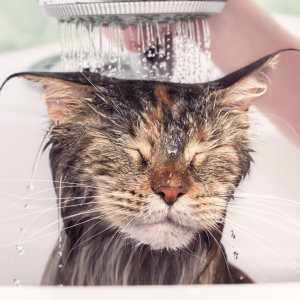
Pestisafe® Control Inside
After washing your furry friend(s) it is important to focus on removing the flea infestation inside your home to prevent re-infestation to your pets. Indoors, if there are 5 or more fleas spotted, in under a minute, this means there is a serious infestation.
Cultural Control
The first step of any successful IPM program is laying the groundwork for proper sanitation & cultural control methods. With fleas, it is crucial to vacuum or steam clean daily for 2 weeks. If vacuuming, add a pinch of food-grade diatomaceous earth to your vacuum bag, as this will eliminate any captured adults fleas or larva. If steam-cleaning, you can also add a few drops of TweetMint Enzyme Cleaner® for more effective cleaning & flea control.
Pay special attention to flea “hot spots”, AKA pet bedding and your pet’s favorite sleeping/resting areas. Remember earlier in the article, flea larva love to feed on dried blood and all fleas thrive on organic debris in carpet/flooring, it is important to continue cleaning to destroy their nests, eliminate food sources, and ultimately disrupt their life cycle.
Physical Control
Take some food-grade diatomaceous earth and lightly dust all floors. *Quick tip* “if you see white, it isn’t right”, the DE should be sprinkled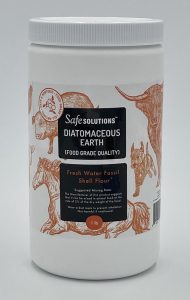 lightly and if you can see it it has been applied too heavily, the fleas will avoid the DE. A Pest-Pistol pump duster can help to apply DE. Let set for overnight and then vacuum the following day.
lightly and if you can see it it has been applied too heavily, the fleas will avoid the DE. A Pest-Pistol pump duster can help to apply DE. Let set for overnight and then vacuum the following day.
Don’t have any DE? You can use baking soda and follow the above directions.
Biological Control
There are a lack of biological control methods for fleas in the home – we will have more on this control method for outside.
Pestisafe® Control
The best control is to use TweetMint® Enzyme Cleaner or Not Nice To Bugs® to eliminate fleas at all steps of their life cycle.
Mop or spray floors with 2 oz (4 tbsp) of TweetMint or Not Nice To Bugs per gallon of water and increase by 0.5 oz (1 tbsp) until control is achieved.
Use the above dilution to spray fleas and control them directly.
Pestisafe® Control Outside
After removing the fleas from your furry friend(s) AND eliminating all fleas from inside your home, it is time to move your attention to outside your home to prevent re-infestation.
It should be noted, outside treatments are not needed unless there is repeated re-infestation to pets. If any treatments are conducted outside,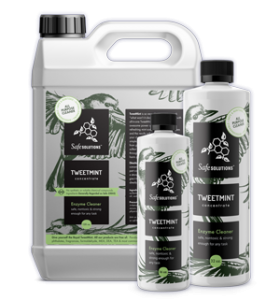 it is important to focus on flea “hot spots” and not random or complete total/broad yard treatments.
it is important to focus on flea “hot spots” and not random or complete total/broad yard treatments.
Cultural Control
Inspection: put on white knee-high socks and walk through areas suspected of flea infestation. If there are fleas, you will see them jumping and landing on the socks.
Wild animals often introduce fleas to homes, yards, and pets, so it is important to reduce their exposure and presence. Such animals that can introduce fleas to homes are, but not limited to: opossums, all sorts of rodents, rabbits, racoons, and more. Making sure wild animals do not have access to your home can go a long way in preventing fleas.
Physical Control
Make sure to mow grass closely to the ground, this will decrease the humidity level at flea breeding/nesting sites and will introduce more sunlight to eliminate the larva.
Trim back all shrubbery and plants that are near to, or touching your home. This will prevent entry into your home for fleas, other pests, and wild animals.
Biological Control
As stated previously, there are a lack of biological control products for inside the home, but there are some methods for outside.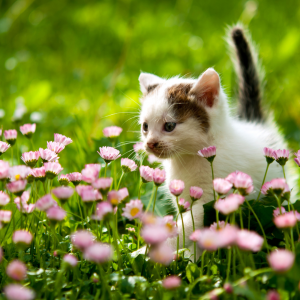
Common flea predators include: earwigs, ants, beetles, and nematodes. All of these predators feed on fleas at various points throughout their life cycle. It is important to not conduct pesticide or poison treatments to your yard. They seldom work, they increase chemical resistance among fleas, AND kill off all of these beneficial insects and predators.
You can spray nematodes throughout your yard to help control fleas. There are many different nematode species, so it is important to research and select the proper species that will work best for your situation.
Pestisafe® Control
If you would like to use the best control for fleas, you may spray either TweetMint® Enzyme Cleaner or Not Nice To Bugs® throughout your yard. Use 2-4 oz (4 – 8 tbsp) per gallon of water.
*Quick tip* you do not need to spray the entire yard, again focus on “hot spots”. Fleas need a specific environment to grow & nest in, these are typically the moist, shaded areas; so spray these areas instead of a larger, broad application.
You can also use TweetMint® Enzyme Cleaner as a repellent for your pets before they go outside. Mix 0.5 – 1 oz (1 – 2 tbsp) in a quart of water and spritz the solution all over your pet before they go outside. The peppermint will repel fleas & biting insects. *Bonus* you can use this same solution to eliminate pet B.O. after playing fetch or playtime.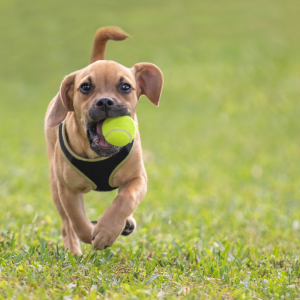
Final Thoughts
The most common products on the market for flea control are very harmful & dangerous neurotoxins. These same products that are supposed to protect pets, lead to thousands of pet deaths each year. Take this article from CBS News that details the most recent flea collar scandal.
There is simply no need to use pesticides when controlling fleas, as so many safer, natural alternatives exist!
If you would like an even more in-depth explanation of fleas & how to control them; read the full chapter at www.thebestcontrol2.com
Enjoy these articles? Continue following our Bug Blog so you won’t miss the next one!
– Gage

